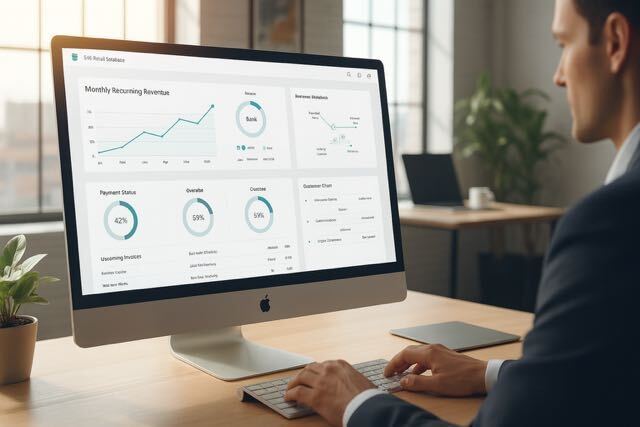How the Right MSP Assessments Can Help with Your Business Growth

The Right MSP Assessments: How They Can Help Your Business
When running a managed service provider business, you’ll have a lot of balls to juggle. Much of the work you do on behalf of your clients will be highly technical and requires deep expertise. But your clients may not have the time, knowledge, or inclination to get to grips with the jargon. Conversely, you may report to a CIO who wants highly in-depth information. That’s where the right MSP assessments and reports come into play.
Depending on who you are reporting to in your client’s organization and the purpose of your client communications, the right managed service provider assessments can help you deliver the most impactful information at the right time.
What is an MSP Assessment?
An MSP Assessment is an action plan that can be used to assess the health of the customer's IT infrastructure, network, and systems, as well as other IT assets. The assessment uncovers areas of action - from green to red - on level of severity and required action.
Based upon the issues identified in the assessment, the managed service providers create a plan. The objective of this plan is to remediate issues turning areas of action into ‘green’ from ‘red’.
An assessment contains the essential performance measures that you and your client agreed upon in your service level agreement. It can also be used to analyze your performance as a managed service provider, in addition to giving your clients an indication of the status of their IT services. These provide an opportunity to establish rapport and trust between your firm and a possible buyer.
In general, an assessment helps you diagnose any upcoming problem areas and gain trust by providing information that helps prospects choose what's right for their business. These assessments may contain information on:
- The health of your client’s overall infrastructure
- Network and system performance
- Any bugs or security threats that were dealt with within a given time
- Updates on previously agreed upon performance metrics or SLAs
- Potential areas for improvement
- Recommended infrastructure investments and improvements in the near future
Benefits of Creating and Sending MSP Assessments
- Builds trust in your working relationships with clients
MSP assessments allow you to schedule client calls and provide hard-and-fast data that prove ROI in a remote working relationship. Even if regular virtual or in-person touchpoints with your clients are not possible, a well-structured report helps to overcome this and build trust through proven results.
- Educates the client on your ongoing value
Your services might represent a hefty chunk of their budget whenever your client is examining their monthly or annual outgoings. So it’s essential to continuously validate the money they spend on your contract. Without clearly defined KPIs and trackable, understandable metrics in front of them regularly, your client may forget why they are paying you and start to believe they don’t need your services at all.
MSP assessments ensure that the detailed work you do is appropriately represented to the client. Well-built client assessments also verify your MSP value proposition, whether through the management and prevention of costly security threats or the optimization of their infrastructure or tech stacks.
Types of MSP Assessments
When creating your MSP assessments, it’s essential to consider
- Who will be viewing the assessment.
- What insights you’ll want them to take from it.
These are some of the popular assessments that can assist you in gaining a competitive edge while establishing trust with your prospect:
Monthly Client reporting
Client reporting is a meeting between a vendor and their customer once every month. These reports can vary greatly depending on which client will receive them. Consider the position of the person who will be viewing the report, what will they understand, and what will they care about?
Client MSP assessments typically document the strategy, expertise, and work you devote to them on an ongoing basis. They can be sent monthly, quarterly, annually, or a combination of all three.
Patch assessments are an example of insights you can include in your reporting. They outline open issues, resolved issues, and any upgrades or enhancements made. Another example is assessments that include active users, added and removed users, and usage metrics.
Regardless of how detailed your assessments are or how often you choose to send them, they should outline:
- Performance according to KPIs and agreed-upon metrics
- Software inventory and performance
- Network assessment
- Recommended upgrades
Here are a few examples of client reporting,
Client risk assessments are the executive summary of overall risk, issue summary, and proposed recommendations in order to immediately correct both simple and complex problems.
These assessments should cover the issues involved in user passwords, internet speed tests, asset summaries detailing equipment on the network, active and inactive users, and more that gives pertinent insight into the network.
External vulnerability scan assessment can give you a detailed assessment of the network to see how susceptible the business is to outside threats from hackers, security by-passers, and general data theft.
This assessment should also contain what are the kind of steps your clients need to take in order to shore up the network. This will make it harder to get past firewalls and through other key access points.
Network management assessment will prioritize the challenges a particular network is facing and custom tailors all of the recommendations accordingly.
Most networks might have plenty of issues that need to be solved and this assessment should provide all of the steps that they need to take, in order of most critical to least. This enables CEOs to make decisions that meet available constraints - whether budget, human capital, or additional resources are sparse.
Quarterly Business Reviews (QBR)
A quarterly business review is a meeting between a vendor and their customer once every quarter. During a QBR, both parties discuss how the vendor supports the customer's business and how the customer's business and employees might be better supported.
Every QBR should include:
- Major events happened in the previous three months
- Successes and setbacks encountered
- Steps taken to resolve the problems
- The state of customer's technology products at the moment
- Any recent business developments that affect customer’s technology services, such as hiring more people or opening a new location.
- The IT roadmap to assess existing projects and deadlines
It takes time and effort to establish good QBR procedures and enable the ecosystem. Once these issues are resolved, the QBR can genuinely serve as the organization's nerve center, conveying important impulses and strategic signals.
vCIO and Business Technology Consultant Reporting
vCIO and Business Technology Consultant reporting is an assessment that is directly sent to a CIO or a business owner for some of your clients. These types of assessments require much more strategic information. You’ll likely send these assessments less frequently than standard client assessments and schedule meetings around them. MSPs who are in charge of the technology should discuss the reports and propose strategies with your client. This, in turn, will help to gain a higher level of trust within the organization.
CIO assessments often include long-term plans and strategies - anywhere from one to three years into the future. They should show that you understand your client’s objectives and outline how you will support them in these goals.
These types of assessments can cover:
- Opportunities to streamline and optimize the infrastructure and technology stack
- Consolidation opportunities to save costs
- Old or redundant systems that can be retired
- Compliance-related issues and how they will be addressed
- Identification of opportunities for improvement to operational efficiency
Why Use a Software to Generate Assessments?
Many MSPs utilize software to generate detailed assessments outlining cost and efficiency savings for their clients. But it’s also important to look inwards and see how you can increase the efficiency of your operations. By using a software to generate assessments, MSPs can easily,
- Identify the bottlenecks that are causing problems
- Set a baseline for normal performance
- Determine the capabilities & shortcomings of the client’s network
- Manage client’s hardware inventory and their IT assets
- Receive documentation of the findings and more..
With Zomentum , you can create thorough recommendation assessments. This will help you to present essential information to your clients with intuitive assessments that clearly show the value of your services.
Zomentum Grow’s sales assessments allow you to examine your potential customers' technological needs. With Sales Assessments, you can help your clients understand complex technology challenges with an intuitive risk matrix and make expert recommendations. Most importantly, risk assessments can assist you in gaining a competitive edge. Identify potential gaps in their IT infrastructure health and recommend proactive measures for long-term business outcomes.
Ready to see our Zomentum in action? Book a demo today and discover how we can help your business grow.





.png)









